Kazakhstan
Republic of Kazakhstan | ||
|---|---|---|
| Anthem: Менің Қазақстаным (Kazakh) Tatar | ||
| Religion |
| |
| Demonym(s) | Kazakh Kazakhstani[a] | |
| Government | Unitary presidential republic under an authoritarian government[6][7] | |
| Kassym-Jomart Tokayev | ||
| Oljas Bektenov | ||
| Legislature | Kirghiz ASSR | 26 August 1920 |
| 19 June 1925 | ||
| 5 December 1936 | ||
• Declaration of sovereignty | 25 October 1990 | |
• Reconstituted as the Republic of Kazakhstan | 10 December 1991 | |
• Independence from the USSR | 16 December 1991 | |
| 26 December 1991 | ||
| 30 August 1995 | ||
| Area | ||
• Total | 2,724,900 km2 (1,052,100 sq mi) (9th) | |
• Water (%) | 1.7 | |
| Population | ||
• 2024 estimate | 20,075,271[8] (62nd) | |
• Density | 7/km2 (18.1/sq mi) (236th) | |
| GDP (PPP) | 2024 estimate | |
• Total | ||
• Per capita | ||
| GDP (nominal) | 2024 estimate | |
• Total | ||
• Per capita | ||
| Gini (2018) | low | |
| HDI (2022) | very high (67th) | |
| Currency | Tenge (₸) (KZT) | |
| Time zone | UTC+5 (West / East) | |
| ISO 3166 code | KZ | |
| Internet TLD | ||
Kazakhstan,[b] officially the Republic of Kazakhstan,[c] is a landlocked country mostly in Central Asia, with a part in Eastern Europe.[d] It borders Russia to the north and west, China to the east, Kyrgyzstan to the southeast, Uzbekistan to the south, and Turkmenistan to the southwest, with a coastline along the Caspian Sea. Its capital is Astana, while the largest city and leading cultural and commercial hub is Almaty. Kazakhstan is the world's ninth-largest country by land area and the largest landlocked country. It has a population of 20 million and one of the lowest population densities in the world, at fewer than 6 people per square kilometre (16 people/sq mi).[14] Ethnic Kazakhs constitute a majority, while ethnic Russians form a significant minority. Officially secular, Kazakhstan is a Muslim-majority country, although ethnic Russians in the country form a sizeable Christian community.
Kazakhstan has been inhabited since the Paleolithic era. In antiquity, various nomadic Iranian peoples such as the Saka, Massagetae, and Scythians dominated the territory, with the Achaemenid Persian Empire expanding towards the southern region. Turkic nomads entered the region from as early as the sixth century. In the 13th century, the area was subjugated by the Mongol Empire under Genghis Khan. Following the disintegration of the Golden Horde in the 15th century, the Kazakh Khanate was established over an area roughly corresponding with modern Kazakhstan. By the 18th century, the Kazakh Khanate had fragmented into three jüz (tribal divisions), which were gradually absorbed and conquered by the Russian Empire; by the mid-19th century, all of Kazakhstan was nominally under Russian rule.[15] Following the 1917 Russian Revolution and subsequent Russian Civil War, the territory was reorganized several times. In 1936, its modern borders were established with the formation of the Kazakh Soviet Socialist Republic within the Soviet Union. Kazakhstan was the last Soviet republic to declare independence during the dissolution of the Soviet Union from 1988 to 1991.
Kazakhstan dominates Central Asia
Etymology
The English word Kazakh, meaning a member of the Kazakh people, derives from Russian: казах.[21] The native name is Kazakh: қазақ, romanized: qazaq. It might originate from the Turkic word verb qaz-, 'to wander', reflecting the Kazakhs' nomadic culture.[22] The term 'Cossack' is of the same origin.[22]
In
Though Kazakh traditionally referred only to ethnic Kazakhs, including those living in China, Russia, Turkey, Uzbekistan and other neighbouring countries, the term is increasingly being used to refer to any inhabitant of Kazakhstan, including residents of other ethnicities.[25]
History
This section needs additional citations for verification. (December 2018) |

Kazakhstan has been inhabited since the Paleolithic era.[26] The Botai culture (3700–3100 BC) is credited with the first domestication of horses. The Botai population derived most of their ancestry from a deeply European-related population known as Ancient North Eurasians, while also displaying some Ancient East Asian admixture.[27] Pastoralism developed during the Neolithic. The population was Caucasoid during the Bronze and Iron Age period.[28][29]
The Kazakh territory was a key constituent of the Eurasian trading
In 329 BC, Alexander the Great and his Macedonian army fought in the Battle of Jaxartes against the Scythians along the Jaxartes River, now known as the Syr Darya along the southern border of modern Kazakhstan.
Cuman-Kipchak and the Golden Horde

The main migration of Turkic peoples occurred between the 5th and 11th centuries when they spread across most of Central Asia. The Turkic peoples slowly replaced and assimilated the previous Iranian-speaking locals, turning the population of Central Asia from largely Iranian, into primarily of East Asian descent.[35]
The
The
Kazakh Khanate
In 1465, the Kazakh Khanate emerged as a result of the dissolution of the Golden Horde. Established by Janibek Khan and Kerei Khan, it continued to be ruled by the Turco-Mongol clan of Tore (Jochid dynasty). Throughout this period, traditional nomadic life and a livestock-based economy continued to dominate the steppe. In the 15th century, a distinct Kazakh identity began to emerge among the Turkic tribes. This was followed by the Kazakh War of Independence, where the Khanate gained its sovereignty from the Shaybanids. The process was consolidated by the mid-16th century with the appearance of the Kazakh language, culture, and economy.
Nevertheless, the region was the focus of ever-increasing disputes between the native Kazakh
During the 17th century, the Kazakhs fought the
Russian Kazakhstan


In the first half of the 18th century, the
The Russian Empire introduced a system of administration and built military garrisons and barracks in its effort to establish a presence in Central Asia in the so-called "Great Game" for dominance in the area against the British Empire, which was extending its influence from the south in India and Southeast Asia. Russia built its first outpost, Orsk, in 1735. Russia introduced the Russian language in all schools and governmental organisations.
Russia's efforts to impose its system aroused the resentment of the Kazakhs, and, by the 1860s, some Kazakhs resisted its rule. Russia had disrupted the traditional nomadic lifestyle and livestock-based economy, and people were suffering from starvation, with some Kazakh tribes being decimated. The Kazakh national movement, which began in the late 19th century, sought to preserve the native language and identity by resisting the attempts of the Russian Empire to assimilate and stifle Kazakh culture.
From the 1890s onward, ever-larger numbers of settlers from the Russian Empire began
The competition for land and water that ensued between the Kazakhs and the newcomers caused great resentment against colonial rule during the final years of the Russian Empire. The most serious uprising, the Central Asian revolt, occurred in 1916. The Kazakhs attacked Russian and Cossack settlers and military garrisons. The revolt resulted in a series of clashes and in brutal massacres committed by both sides.[42] Both sides resisted the communist government until late 1919.
Kazakh SSR
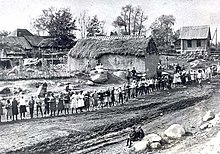
Following the
Soviet repression of the traditional elite, along with forced
On 5 December 1936, the
The republic was one of the destinations for exiled and convicted persons, as well as for mass resettlements, or deportations affected by the central USSR authorities during the 1930s and 1940s, such as approximately 400,000
The
In 1947, the USSR, as part of its atomic bomb project, founded an atomic bomb test site near the north-eastern town of Semipalatinsk, where the first Soviet nuclear bomb test was conducted in 1949. Hundreds of nuclear tests were conducted until 1989 with adverse consequences for the nation's environment and population.[47] The Anti-nuclear movement in Kazakhstan became a major political force in the late 1980s.
In April 1961, Baikonur became the springboard of Vostok 1, a spacecraft with Soviet cosmonaut Yuri Gagarin being the first human to enter space.
In December 1986, mass demonstrations by young ethnic Kazakhs, later called the
Independence
On 25 October 1990, Kazakhstan declared its
Kazakhstan's communist-era leader, Nursultan Nazarbayev, became the country's first President. Nazarbayev ruled in an authoritarian manner. An emphasis was placed on converting the country's economy to a market economy while political reforms lagged behind economic advances. By 2006, Kazakhstan was generating 60 percent of the GDP of Central Asia, primarily through its oil industry.[16]
In 1997, the government moved the capital to Astana, renamed Nur-Sultan on 23 March 2019,[49] from Almaty, Kazakhstan's largest city, where it had been established under the Soviet Union.[50]
In March 2011, Nazarbayev outlined the progress made toward democracy by Kazakhstan. On 19 March 2019, Nazarbayev announced his resignation from the presidency.[53] Kazakhstan's senate speaker Kassym-Jomart Tokayev won the 2019 presidential election that was held on 9 June.[54] His first official act was to rename the capital after his predecessor.[55] In June 2019, the new president, Kassym-Jomart Tokayev, won Kazakhstan's presidential election.[56] In January 2022, the country plunged into
Geography
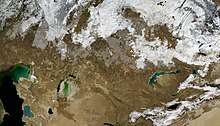
As it extends across both sides of the
With an area of 2,700,000 square kilometres (1,000,000 sq mi) – equivalent in size to Western Europe – Kazakhstan is the ninth-largest country and largest landlocked country in the world. While it was part of the Russian Empire, Kazakhstan lost some of its territory to China's Xinjiang province,[60] and some to Uzbekistan's Karakalpakstan autonomous republic during Soviet years.

It shares borders of 6,846 kilometres (4,254 mi) with Russia, 2,203 kilometres (1,369 mi) with
Kazakhstan's terrain extends west to east from the
The
Kazakhstan's
Natural resources
Kazakhstan has an abundant supply of accessible mineral and fossil fuel resources. Development of petroleum, natural gas, and mineral extractions has attracted most of the over $40 billion in foreign investment in Kazakhstan since 1993 and accounts for some 57 percent of the nation's industrial output (or approximately 13 percent of gross domestic product). According to some estimates,[64] Kazakhstan has the second largest uranium, chromium, lead, and zinc reserves; the third largest manganese reserves; the fifth largest copper reserves; and ranks in the top ten for coal, iron, and gold. It is also an exporter of diamonds. Perhaps most significant for economic development, Kazakhstan also has the 11th largest proven reserves of both petroleum and natural gas.[65] One such location is the Tokarevskoye gas condensate field.
In total, there are 160 deposits with over 2.7 billion tonnes (2.7 billion long tons) of petroleum. Oil explorations have shown that the deposits on the
Kazakhstan also possesses large deposits of phosphorite. Two of the largest deposits include the Karatau basin with 650 million tonnes of P2O5 and the Chilisai deposit of the Aqtobe phosphorite basin located in northwestern Kazakhstan, with resources of 500–800 million tonnes of 9 percent ore.[68][69]
On 17 October 2013, the Extractive Industries Transparency Initiative (EITI) accepted Kazakhstan as "EITI Compliant", meaning that the country has a basic and functional process to ensure the regular disclosure of natural resource revenues.[70]
Climate
Kazakhstan has an "extreme"

| Location | July (°C) | July (°F) | January (°C) | January (°F) |
|---|---|---|---|---|
| Almaty | 30/18 | 86/64 | 0/−8 | 33/17 |
Şymkent |
32/17 | 91/66 | 4/−4 | 39/23 |
Qarağandy |
27/14 | 80/57 | −8/−17 | 16/1 |
| Astana | 27/15 | 80/59 | −10/−18 | 14/−1 |
| Pavlodar | 28/15 | 82/59 | −11/−20 | 12/−5 |
Aqtobe |
30/15 | 86/61 | −8/−16 | 17/2 |
Wildlife
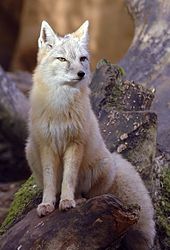
There are ten nature reserves and ten national parks in Kazakhstan that provide safe haven for many rare and endangered plants and animals. Common plants are Astragalus, Gagea, Allium, Carex and Oxytropis; endangered plant species include native wild apple (Malus sieversii), wild grape (Vitis vinifera) and several wild tulip species (e.g., Tulipa greigii) and rare onion species Allium karataviense, also Iris willmottiana and Tulipa kaufmanniana.[73][74] Kazakhstan had a 2019 Forest Landscape Integrity Index mean score of 8.23/10, ranking it 26th globally out of 172 countries.[75]
Common mammals include the
Government and politics
Political system
Officially, Kazakhstan is a democratic, secular, constitutional

|
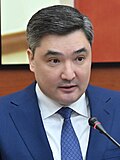
|
| Kassym-Jomart Tokayev President |
Oljas Bektenov Prime Minister of Kazakhstan |
Kazakhstan has a
Political reforms
Reforms have begun to be implemented after the election of Kassym-Jomart Tokayev in June 2019. Tokayev supports a culture of opposition, public assembly, and loosening rules on forming political parties.[83] In June 2019, Tokayev established the National Council of Public Trust as a public platform for national conversation regarding government policies and reforms.[84] In July 2019, the President of Kazakhstan announced a concept of a 'listening state' that quickly and efficiently responds to all constructive requests of the country's citizens.[85] A law will be passed to allow representatives from other parties to hold chair positions on some Parliamentary committees, to foster alternative views and opinions.[when?] The minimum membership threshold needed to register a political party will be reduced from 40,000 to 20,000 members.[84] Special places for peaceful rallies in central areas will be allocated and a new draft law outlining the rights and obligations of organisers, participants and observers will be passed.[84] In an effort to increase public safety, President Tokayev has strengthened the penalties for those who commit crimes against individuals.[84]
On 17 September 2022, Tokayev signed a decree that limits presidential tenure to one term of seven years.[86] He furthermore announced the preparation of a new reform package to "decentralize" and "distribute" power between government institutions. The reform package also seeks to modify the electoral system and increase the decision-making authorities of Kazakhstan's regions.[87] The powers of the parliament were expanded at the expense of those of the president, relatives of whom are now also barred from holding government positions, while the Constitutional Court was restored and the death penalty abolished.[87][88]
Administrative divisions
Kazakhstan is divided into seventeen regions (Kazakh: облыстар, oblystar; Russian: области, oblasti) plus three cities (Almaty, Astana and Şymkent) which are independent of the region in which they are situated. The regions are subdivided into 177 districts (Kazakh: аудандар, audandar; Russian: районы, rayony).[89] The districts are further subdivided into rural districts at the lowest level of administration, which include all rural settlements and villages without an associated municipal government.[90]
The cities of
Each region is headed by an äkim (regional governor) appointed by the president. District äkimi are appointed by regional akims. Kazakhstan's government relocated its capital from Almaty, established under the Soviet Union, to Astana on 10 December 1997.[93]
Municipal divisions
Municipalities exist at each level of administrative division in Kazakhstan. Cities of republican, regional, and district significance are designated as urban inhabited localities; all others are designated rural.[90] At the highest level are the cities of Almaty and Astana, which are classified as cities of republican significance on the administrative level equal to that of a region.[89] At the intermediate level are cities of regional significance on the administrative level equal to that of a district. Cities of these two levels may be divided into city districts.[89] At the lowest level are cities of district significance, and over two-thousand villages and rural settlements (aul) on the administrative level equal to that of rural districts.[89]
Urban centres
| Rank | Name | Region | Pop. | ||||||
|---|---|---|---|---|---|---|---|---|---|
 Almaty  Astana |
1 | Almaty | Almaty | 1,854,656 | Qarağandy
| ||||
| 2 | Astana | Astana | 1,078,384 | ||||||
| 3 | Şymkent |
Shymkent | 1,009,086 | ||||||
| 4 | Qarağandy |
Qarağandy |
497,712 | ||||||
| 5 | Aqtobe |
Aqtobe |
487,994 | ||||||
| 6 | Taraz | Jambyl | 357,791 | ||||||
| 7 | Pavlodar | Pavlodar | 333,989 | ||||||
| 8 | Öskemen |
East Kazakhstan | 331,614 | ||||||
| 9 | Semey | Abai | 323,138 | ||||||
| 10 | Atyrau | Atyrau | 269,720 | ||||||
Foreign relations

Kazakhstan is a member of the Commonwealth of Independent States, the
Kazakhstan is also a member of the United Nations,
In 1999, Kazakhstan had applied for observer status at the
Since independence in 1991, Kazakhstan has pursued what is known as the "multi-vector foreign policy" (Kazakh: көпвекторлы сыртқы саясат), seeking equally good relations with its two large neighbours, Russia and China, as well as with the United States and the rest of the Western world.[99][100] Russia leases approximately 6,000 square kilometres (2,317 sq mi) of territory enclosing the Baikonur Cosmodrome space launch site in south central Kazakhstan, where the first man was launched into space as well as Soviet space shuttle Buran and the well-known space station Mir.
On 11 April 2010, presidents Nazarbayev and Obama met at the Nuclear Security Summit in Washington, D.C., and discussed strengthening the strategic partnership between the United States and Kazakhstan. They pledged to intensify bilateral co-operation to promote nuclear safety and non-proliferation, regional stability in Central Asia, economic prosperity, and universal values.[101]
Since 2014, the Kazakhstani government has been bidding for a non-permanent member seat on the UN Security Council for 2017–2018.[102] On 28 June 2016 Kazakhstan was elected as a non-permanent member to serve on the UN Security Council for a two-year term.[103]

Kazakhstan has supported UN peacekeeping missions in Haiti, Western Sahara, and Côte d'Ivoire.[104] In March 2014, the Ministry of Defense chose 20 Kazakhstani military men as observers for the UN peacekeeping missions. The military personnel, ranking from captain to colonel, had to go through specialised UN training; they had to be fluent in English and skilled in using specialised military vehicles.[104]
In 2014, Kazakhstan gave Ukraine humanitarian aid during the conflict with Russian-backed rebels. In October 2014, Kazakhstan donated $30,000 to the International Committee of the Red Cross's humanitarian effort in Ukraine. In January 2015, to help the humanitarian crisis, Kazakhstan sent $400,000 of aid to Ukraine's southeastern regions.[105] President Nazarbayev said of the war in Ukraine, "The fratricidal war has brought true devastation to eastern Ukraine, and it is a common task to stop the war there, strengthen Ukraine's independence and secure territorial integrity of Ukraine."[106] Experts believe that no matter how the Ukraine crisis develops, Kazakhstan's relations with the European Union will remain normal.[107] It is believed that Nazarbayev's mediation is positively received by both Russia and Ukraine.[107]
Kazakhstan's Ministry of Foreign Affairs released a statement on 26 January 2015: "We are firmly convinced that there is no alternative to peace negotiations as a way to resolve the crisis in south-eastern Ukraine."[108] In 2018, Kazakhstan signed the UN treaty on the Prohibition of Nuclear Weapons.[109]

On 6 March 2020, the Concept of the Foreign Policy of Kazakhstan for 2020–2030 was announced. The document outlines the following main points:
- An open, predictable and consistent foreign policy of the country, which is progressive in nature and maintains its endurance by continuing the course of the First President – the country at a new stage of development;
- Protection of human rights, development of humanitarian diplomacy and environmental protection;
- Promotion of the country's economic interests in the international arena, including the implementation of state policy to attract investment;
- Maintaining international peace and security;
- Development of regional and multilateral diplomacy, which primarily involves strengthening mutually beneficial ties with key partners – Russia, China, the United States, Central Asian states and the EU countries, as well as through multilateral structures – the United Nations, the Organization for Security and Co-operation in Europe, the Shanghai Cooperation Organisation, the Commonwealth of Independent States, and others.[110]
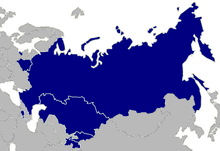
Kazakhstan's memberships of international organisations include:
- Commonwealth of Independent States (CIS)
- Collective Security Treaty Organization (CSTO)
- Shanghai Cooperation Organisation
- Euro-Atlantic Partnership Council
- Individual Partnership Action Plan, with NATO, Ukraine, Georgia, Azerbaijan, Armenia, Moldova, Bosnia and Herzegovina and Montenegro
- TÜRKSOY community. (The national language, Kazakh, is related to the other Turkic languages, with which it shares cultural and historical ties)
- United Nations
- Organization for Security and Co-operation in Europe (OSCE)
- UNESCO, where Kazakhstan is a member of its World Heritage Committee[111]
- Nuclear Suppliers Group as a participating government
- World Trade Organization[112]
- Organization of Islamic Cooperation (OIC)[113]
Based on these principles, following Russia's invasion of Ukraine in February 2022, Kazakhstan has increasingly pursued an independent foreign policy, defined by its own foreign policy objectives and ambitions[114][115] through which the country attempts to balance its relations with "all the major powers and an equally principled aversion towards excessive dependence in any field upon any one of them, while also opening the country up economically to all who are willing to invest there."[116]
Military


Most of Kazakhstan's military was inherited from the Soviet Armed Forces' Turkestan Military District. These units became the core of Kazakhstan's new military. It acquired all the units of the 40th Army (the former 32nd Army) and part of the 17th Army Corps, including six land-force divisions, storage bases, the 14th and 35th air-landing brigades, two rocket brigades, two artillery regiments, and a large amount of equipment that had been withdrawn from over the Urals after the signing of the Treaty on Conventional Armed Forces in Europe. Since the late 20th century, the Kazakhstan Army has focused on expanding the number of its armoured units. Since 1990, armoured units have expanded from 500 to 1,613 in 2005.
The Kazakh air force is composed mostly of Soviet-era planes, including 41
Kazakhstan sent 29 military engineers to
Kazakhstan's
Since 2002, the joint tactical peacekeeping exercise "Steppe Eagle" has been hosted by the Kazakhstan government. "Steppe Eagle" focuses on building coalitions and gives participating nations the opportunity to work together. During the Steppe Eagle exercises, the KAZBAT peacekeeping battalion operates within a multinational force under a unified command within multidisciplinary peacekeeping operations, with NATO and the U.S. Military.[120]
In December 2013, Kazakhstan announced it will send officers to support United Nations Peacekeeping forces in Haiti, Western Sahara, Ivory Coast and Liberia.[121]
Human rights
The
Kazakhstan was ranked 122nd out of 180 countries in
Kazakhstan's human rights situation has been described as poor by independent observers. In its 2015 report of human rights in the country,
According to a U.S. government report released in 2014, in Kazakhstan:
The law does not require police to inform detainees that they have the
right to an attorney, and police did not do so. Human rights observers alleged that law enforcement officials dissuaded detainees from seeing an attorney, gathered evidence through preliminary questioning before a detainee's attorney arrived, and in some cases used corrupt defense attorneys to gather evidence. [...][132]
The law does not adequately provide for anbribes in exchange for favorable rulings in the majority of criminal cases.[132]
Kazakhstan's global rank in the World Justice Project's 2015 Rule of Law Index was 65 out of 102; the country scored well on "Order and Security" (global rank 32/102), and poorly on "Constraints on Government Powers" (global rank 93/102), "Open Government" (85/102) and "Fundamental Rights" (84/102, with a downward trend marking a deterioration in conditions).[133]
The ABA Rule of Law Initiative of the American Bar Association has programs to train justice sector professionals in Kazakhstan.[134][135]
Kazakhstan's Supreme Court has taken steps to modernise and to increase transparency and oversight over the country's legal system. With funding from the US Agency for International Development, the ABA Rule of Law Initiative began a new program in April 2012 to strengthen the independence and accountability of Kazakhstan's judiciary.[136]
In an effort to increase transparency in the criminal justice and court system, and improve human rights, Kazakhstan intended to digitise all investigative, prosecutorial and court records by 2018.[137] Many criminal cases are closed before trial on the basis of reconciliation between the defendant and the victim because they simplify the work of the law-enforcement officers, release the defendant from punishment, and pay little regard to the victim's rights.[138]
Homosexuality has been legal in Kazakhstan since 1997, although it is still socially unacceptable in most areas.[139] Discrimination against LGBT people in Kazakhstan is widespread.[140][141]
Economy


In 2018, Kazakhstan had a GDP of $179.332 billion and an annual growth rate of 4.5 percent. Per capita, Kazakhstan's GDP stood at $9,686.
Kazakhstan's economy grew by 4.6 percent in 2014.
Kazakhstan weathered the global financial crisis [
In March 2002, the
On 29 November 2003, the Law on Changes to Tax Code which reduced
Kazakhstan instituted a pension reform program in 1998. By January 2012, the pension assets were about $17 billion (KZT 2.5 trillion). There are 11 saving pension funds in the country. The State Accumulating Pension Fund, the only state-owned fund, was privatised in 2006. The country's unified financial regulatory agency oversees and regulates pension funds. The growing demand of pension funds for investment outlets triggered the development of the debt securities market. Pension fund capital is being invested almost exclusively in corporate and government bonds, including the government of Kazakhstan Eurobonds. The government of Kazakhstan was studying a project to create a unified national pension fund and transfer all the accounts from the private pension funds into it.[156]
Kazakhstan climbed to 41st on the 2018 Economic Freedom Index published by The Wall Street Journal and The Heritage Foundation.[157]
Foreign trade
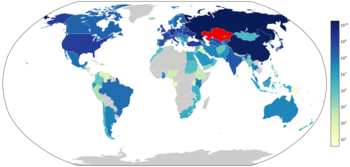
Kazakhstan's increased role in
Kazakhstan's
Agriculture
Agriculture accounts for approximately 5 percent of Kazakhstan's GDP.[91] Grain, potatoes, grapes, vegetables, melons and livestock are the most important agricultural commodities. Agricultural land occupies more than 846,000 square kilometres (327,000 sq mi). The available agricultural land consists of 205,000 km2 (79,000 sq mi) of arable land and 611,000 km2 (236,000 sq mi) of pasture and hay land. Over 80 percent of the country's total area is classified as agricultural land, including almost 70 percent occupied by pasture. Its arable land has the second highest availability per inhabitant (1.5 hectares).[162]
Chief livestock products are dairy products, leather, meat, and wool. The country's major crops include wheat, barley, cotton, and rice. Wheat exports, a major source of hard currency, rank among the leading commodities in Kazakhstan's export trade. In 2003 Kazakhstan harvested 17.6 million tons of grain in gross, 2.8% higher compared to 2002. Kazakhstani agriculture still has many environmental problems from mismanagement during its years in the Soviet Union. Some Kazakh wine is produced in the mountains to the east of Almaty.[163]
Energy
Energy has been the leading economic sector. Production of crude oil and
Kazakhstan launched the Green Economy Plan in 2013. It committed Kazakhstan to meet 50 percent of its energy needs from alternative and renewable sources by 2050.[168] The green economy was projected to increase GDP by 3 percent and create some 500,000 jobs.[169] The government set prices for energy produced from renewable sources. The price of 1 kilowatt-hour for energy produced by wind power plants was set at 22.68 tenge ($0.12), for 1 kilowatt-hour produced by small hydro-power plants 16.71 tenges ($0.09), and from biogas plants 32.23 tenges ($0.18).[170]
Infrastructure

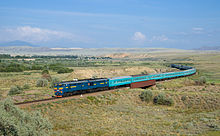
Railways provide 68 percent of all cargo and passenger traffic to over 57 percent of the country. There are 15,333 km (9,527 mi) in common carrier service, excluding industrial lines.[171]15,333 km (9,527 mi) of 1,520 mm (4 ft 11+27⁄32 in) gauge, 4,000 km (2,500 mi) electrified, in 2012.[171] Most cities are connected by railroad; high-speed trains go from Almaty (the southernmost city) to Petropavl (the northernmost city) in about 18 hours.
There is a small 8.56 km (5.32 mi)
The
In 2009, the
Tourism


Kazakhstan is the ninth-largest country by area and the largest landlocked country in the world. As of 2014, tourism accounted for 0.3 percent of Kazakhstan's GDP, but the government had plans to increase it to 3 percent by 2020.[182][183] According to the World Economic Forum's Travel and Tourism Competitiveness Report of 2017, travel and tourism industry GDP in Kazakhstan was $3.08 billion or only 1.6 percent of total GDP. The WEF ranked Kazakhstan 80th in its 2019 report.[184]
In 2017, Kazakhstan ranked 43rd in the number of tourist arrivals. In 2014, The Guardian described tourism in Kazakhstan as "hugely underdeveloped", despite the country's mountain, lake and desert landscapes.[185] Factors hampering an increase in tourism were said to include high prices, "shabby infrastructure", "poor service" and the difficulties of travel in a large underdeveloped country.[185] Even for Kazakhs, going for a holiday abroad may cost only half the price of taking a holiday in Kazakhstan.[185]
The
Kazakhstan has offered a permanent visa-free regime for up to 90 days to citizens of
Foreign direct investment
Kazakhstan has attracted $330 billion in foreign direct investment (FDI) from more than 120 countries since its independence (1991).[189] In 2015, the U.S. State Department said Kazakhstan was widely considered to have the best investment climate in the region.[190] In 2014, President Nazarbayev signed into law tax concessions to promote foreign direct investment which included a 10-year exemption from corporation tax, an eight-year exemption from property tax, and a 10-year freeze on most other taxes.[191] Other incentives include a refund on capital investments of up to 30 percent once a production facility is in operation.[191] In 2012, Kazakhstan attracted $14 billion of foreign direct investment inflows into the country at a 7 percent growth rate.[192] In 2018, $24 billion of FDI was directed into Kazakhstan, a significant increase since 2012.[193]
In 2014, the
Banking
The banking industry of Kazakhstan went through a boom-and-bust cycle in the early 21st century. After several years of rapid expansion in the mid-2000s, the banking industry collapsed in 2008. Several large banking groups, including BTA Bank J.S.C. and Alliance Bank, defaulted soon thereafter. The industry shrank and was restructured, with system-wide loans dropping from 59 percent of GDP in 2007 to 39 percent in 2011. The Kazakh National Bank introduced deposit insurance in a campaign to strengthen the banking sector. Several major foreign banks had branches in Kazakhstan, including RBS, Citibank, and HSBC. Kookmin and UniCredit both entered Kazakhstan's financial services market through acquisitions and stake-building. [citation needed]
Economic competitiveness
According to the 2010–11 World Economic Forum in Global Competitiveness Report, Kazakhstan was ranked 72nd in the world in economic competitiveness.[198] One year later, the Global Competitiveness Report ranked Kazakhstan 50th in most competitive markets.[199]
In the 2020 Doing Business Report by the World Bank, Kazakhstan ranked 25th globally and as the number one best country globally for protecting minority investors' rights.[200] Kazakhstan achieved its goal of entering the top 50 most competitive countries in 2013 and has maintained its position in the 2014–2015 World Economic Forum Global Competitiveness Report that was published at the beginning of September 2014.[201] Kazakhstan is ahead of other states in the CIS in almost all of the report's pillars of competitiveness, including institutions, infrastructure, macroeconomic environment, higher education and training, goods market efficiency, labour market development, financial market development, technological readiness, market size, business sophistication and innovation, lagging behind only in the category of health and primary education.[201] The Global Competitiveness Index gives a score from 1 to 7 in each of these pillars, and Kazakhstan earned an overall score of 4.4.[201]
Corruption
In 2005, the
In 2011, Switzerland confiscated US$48 million in Kazakhstani assets from Swiss bank accounts, as a result of a bribery investigation in the United States.[206] US officials believed the funds represented bribes paid by American officials to Kazakhstani officials in exchange for oil or prospecting rights in Kazakhstan. Proceedings eventually involved US$84 million in the US and another US$60 million in Switzerland.[206]
The Federal Bureau of Investigation (FBI) and the Kazakh Anti-Corruption Agency signed a Mutual Legal Assistance Treaty in February 2015.[207]
Transparency International's 2023 Corruption Perceptions Index, which scored 180 countries on a scale from 0 ("highly corrupt") to 100 ("very clean"), gave Kazakhstan a score of 39. When ranked by score, Kazakhstan ranked 93rd among the 180 countries in the Index, where the country ranked first is perceived to have the most honest public sector.[208] For comparison with worldwide scores, the best score was 90 (ranked 1), the average score was 43, and the worst score was 11 (ranked 180).[209] For comparison with regional scores, the highest score among Eastern European and Central Asian countries [e] was 53, the average score was 35 and the lowest score was 18.[210]
Science and technology

Research remains largely concentrated in Kazakhstan's largest city and former capital, Almaty, home to 52 percent of research personnel. Public research is largely confined to institutes, with universities making only a token contribution. Research institutes receive their funding from national research councils under the umbrella of the Ministry of Education and Science. Their output, however, tends to be disconnected from market needs. In the business sector, few industrial enterprises conduct research themselves.[211][212]

One of the most ambitious targets of the State Programme for Accelerated Industrial and Innovative Development adopted in 2010 is to raise the country's level of expenditure on research and development to 1 percent of GDP by 2015. By 2013, this ratio stood at 0.18 percent of GDP. It will be difficult to reach the target as long as economic growth remains strong.[needs update] Since 2005, the economy has grown faster (by 6 percent in 2013) than gross domestic expenditure on research and development, which only progressed from PPP$598 million to PPP$714 million between 2005 and 2013.[212]
Innovation expenditure more than doubled in Kazakhstan between 2010 and 2011, representing KZT 235 billion (circa US$1.6 billion), or around 1.1 percent of GDP. Some 11 percent of the total was spent on research and development. This compares with about 40 to 70 percent of innovation expenditure in developed countries. This augmentation was due to a sharp rise in product design and the introduction of new services and production methods over this period, to the detriment of the acquisition of machinery and equipment, which has traditionally made up the bulk of Kazakhstan's innovation expenditure. Training costs represented just 2 percent of innovation expenditure, a much lower share than in developed countries.[211][212] Kazakhstan was ranked 81st in the Global Innovation Index in 2023.[213]
In December 2012, President Nursultan Nazarbayev announced the Kazakhstan 2050 Strategy with the slogan "Strong Business, Strong State." This pragmatic strategy proposes sweeping socio-economic and political reforms to hoist Kazakhstan among the top 30 economies by 2050. In this document, Kazakhstan gives itself 15 years to evolve into a knowledge economy. New sectors are to be created during each five-year plan. The first of these, covering the years 2010–2014, focused on developing industrial capacity in car manufacturing, aircraft engineering and the production of locomotives, passenger and cargo railroad cars. During the second five-year plan to 2019, the goal is to develop export markets for these products. To enable Kazakhstan to enter the world market of geological exploration, the country intends to increase the efficiency of traditional extractive sectors such as oil and gas. It also intends to develop rare earth metals, given their importance for electronics, laser technology, communication and medical equipment. The second five-year plan coincides with the development of the Business 2020 roadmap for small and medium-sized enterprises (SMEs), which makes provision for the allocation of grants to SMEs in the regions and for microcredit. The government and the National Chamber of Entrepreneurs also plan to develop an effective mechanism to help start-ups.[212]
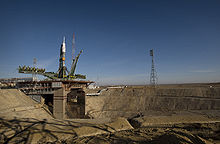
During subsequent five-year plans to 2050, new industries will be established in fields such as mobile, multi-media, nano- and space technologies, robotics, genetic engineering and alternative energy. Food processing enterprises will be developed with an eye to turning the country into a major regional exporter of beef, dairy and other agricultural products. Low-return, water-intensive crop varieties will be replaced with vegetable, oil and fodder products. As part of the shift to a "green economy" by 2030, 15% of acreage will be cultivated with water-saving technologies. Experimental agrarian and innovational clusters will be established and drought-resistant genetically modified crops developed.[212]
The Kazakhstan 2050 Strategy fixes a target of devoting 3 percent of GDP to research and development by 2050 to allow for the development of new high-tech sectors.[212]
The Digital Kazakhstan program was launched in 2018 to boost the country's economic growth through the implementation of digital technologies. Kazakhstan's digitization efforts generated 800 billion tenges (US$1.97 billion) in two years. The program helped create 120,000 jobs and attracted 32.8 billion tenges (US$80.7 million) of investment into the country.
Around 82 percent of all public services became automated as part of the Digital Kazakhstan program.[214]
Demographics


The
The 2009 population estimate is 6.8 percent higher than the population reported in the last census from January 1999. The decline in population that began after 1989 has been arrested and possibly reversed. Men and women make up 48.3 and 51.7 percent of the population, respectively.
Ethnic groups
As of 2024, ethnic
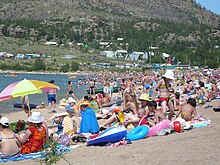
Significant Russian immigration was also connected with the
The 1990s were marked by the emigration of many of the country's Russians, Ukrainians and Volga Germans, a process that began in the 1970s. This has made indigenous Kazakhs the largest ethnic group.[227] Additional factors in the increase in the Kazakhstani population are higher birthrates and immigration of ethnic Kazakhs from China, Mongolia, and Russia.
Languages
Kazakhstan is officially a bilingual country.[228] Kazakh (part of the Kipchak sub-branch of the Turkic languages)[229] is spoken natively by 64.4 percent of the population and has the status of "state language". Russian is spoken by most Kazakhs,[230] has equal status to Kazakh as an "official language", and is used routinely in business, government, and inter-ethnic communication.[231]
The government announced in January 2015 that the
Religion
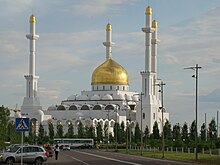
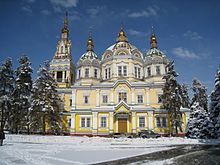

According to the 2021 census, 69.3% of the population is
Kazakhstan is a secular state whose constitution guarantees religious freedoms. Article 39 of the constitution states: "Human rights and freedoms shall not be restricted in any way." Article 14 prohibits "discrimination on religious basis" and Article 19 ensures that everyone has the "right to determine and indicate or not to indicate his/her ethnic, party and religious affiliation." The Constitutional Council affirmed these rights in a 2009 declaration, which stated that a proposed law limiting the rights of certain individuals to practice their religion was declared unconstitutional.[235]
Islam is the largest religion in Kazakhstan, followed by Eastern Orthodox Christianity. After decades of religious suppression by the Soviet Union, the coming of independence witnessed a surge in the expression of ethnic identity, partly through religion. The free practice of religious beliefs and the establishment of full freedom of religion led to an increase of religious activity. Hundreds of mosques, churches, and other religious structures were built in the span of a few years, with the number of religious associations rising from 670 in 1990 to 4,170 today.[236]
Some figures show that
According to the 2009 Census data, there are very few Christians outside the Slavic and Germanic ethnic groups.[244]
Education
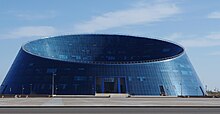
Education is universal and mandatory through to the secondary level and the adult literacy rate is 99.5%.[245] On average, these statistics are equal to both women and men in Kazakhstan.[246]
Education consists of three main phases: primary education (forms 1–4), basic general education (forms 5–9) and senior level education (forms 10–11 or 12) divided into continued general education and vocational education. Vocational Education usually lasts three or four years.[247] (Primary education is preceded by one year of pre-school education.) These levels can be followed in one institution or in different ones (e.g., primary school, then secondary school). Recently, several secondary schools, specialised schools, magnet schools, gymnasiums, lyceums and linguistic and technical gymnasiums have been founded. Secondary professional education is offered in special professional or technical schools, lyceums or colleges and vocational schools.[245]
At present, there are
Over 2,500 students in Kazakhstan have applied for student loans totalling about $9 million. The largest number of student loans come from Almaty, Astana and Kyzylorda.[248]
The training and skills development programs in Kazakhstan are also supported by international organisations. For example, on 30 March 2015, the World Banks' Group of Executive Directors approved a $100 million loan for the Skills and Job project in Kazakhstan.[249] The project aims to provide training to unemployed, unproductively self-employed, and employees in need of training.[249]
Culture
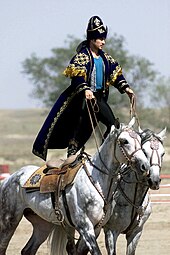
Before the Russian colonisation, the Kazakhs had a highly developed culture based on their nomadic pastoral economy.
Kazakhstan is home to a large number of prominent contributors to literature, science and philosophy:
Tourism is a rapidly growing industry in Kazakhstan and it is joining the international tourism networking. In 2010, Kazakhstan joined The Region Initiative (TRI) which is a Tri-regional Umbrella of Tourism-related organisations. TRI is functioning as a link between three regions: South Asia, Central Asia, and Eastern Europe. Armenia, Bangladesh, Georgia, Kazakhstan, Kyrgyzstan, India, Nepal, Pakistan, Russia, Sri Lanka, Tajikistan, Turkey, and Ukraine are now partners, and Kazakhstan is linked with other South Asian, Eastern European, and Central Asian countries in the tourism market.
Literature
Kazakh literature is defined as "the body of literature, both

According to Chinese written sources from the 6th–8th centuries CE, the Turkic tribes of Kazakhstan had an oral poetry tradition. These came from earlier periods and were primarily transmitted by
Other notable bards include Kaztugan Žyrau, Žiembet Žyrau, Axtamberdy Žyrau, and Buxar Žyrau Kalkamanuly, who was an advisor to
The preeminent role in the development of modern literary Kazakh belongs to Abai Qunanbaiuly (Kazakh: Абай Құнанбайұлы, sometimes Russified to Abay Kunanbayev, Абай Кунанбаев) (1845–1904), whose writings did much to preserve Kazakh folk culture. Abai's major work is The Book of Words (Kazakh: қара сөздері, Qara sözderi), a philosophical treatise and collection of poems where he criticises Russian colonial policies and encourages other Kazakhs to embrace education and literacy. The literary magazines Ay Qap (published between 1911 and 1915 in Arabic script) and Qazaq (published between 1913 and 1918) played an important role in the development of the intellectual and political life among early 20th-century Kazakhs.[256]
Music
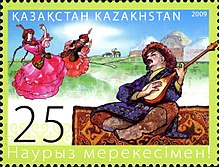
The modern state of Kazakhstan is home to the Kazakh State Kurmangazy Orchestra of Folk Instruments, the Kazakh State Philharmonic Orchestra, the Kazakh National Opera and the Kazakh State Chamber Orchestra. The folk instrument orchestra was named after
When referring to traditional Kazakh music, authentic folklore must be separated from "folklorism". The latter denotes music executed by academically trained performers who aim at preserving the traditional music for coming generations. As far as can be reconstructed, the music of Kazakhstan from the period before a strong Russian influence consists of instrumental music and vocal music. Instrumental music, with the pieces ("Küy") being performed by soloists. Text is often seen in the background (or "program") for the music, as a lot of Küy titles refer to stories. Vocal music, either as part of a ceremony such as a wedding (mainly performed by women), or as part of a feast. Here we might divide into subgenres: epic singing, containing not only historical facts, but as well the tribe's genealogy, love songs, and didactic verses; and as a special form the composition of two or more singers in public (Aitys), of dialogue character and usually unexpectedly frankly in content.

The Russian influence on the music life in Kazakhstan can be seen in two spheres: first, the introduction of musical academic institutions such as concert houses with opera stages, and conservatories, where European music was performed and taught, and second, by trying to incorporate Kazakh traditional music into these academic structures. Controlled first by the
The Kazakhs themselves, however, did not write their own music in notation until 1931. Later, as part of the Soviet Union, Kazakh folk culture was encouraged in a sanitised manner designed to avoid political and social unrest. The result was a bland derivative of real Kazakh folk music. In 1920,
Fine arts
In Kazakhstan, the fine arts, in the classical sense, have their origins in the second half of the 19th century and the beginning of the 20th century. It was largely influenced by Russian artists, such as Vasily Vereshchagin and Nikolai Khludov, who intensively travelled in Central Asia. Khludov had a particular influence on the development of the local school of painting, becoming the teacher of many local artists. The most famous of these is Abilkhan Kasteyev, after whom the State Museum of Art of Kazakhstan was renamed in 1984.[259]
The Kazakh school of fine arts was fully formed by the 1940s and flourished in the 1950s. Local painters, graphic artists and sculptors, trained under the unified Soviet system of artist education, began active work, often using national motifs in their art. The painters O. Tansykbaev, J. Shardenov, K. Telzhanov, and S. Aitbaev, graphic artists E. Sidorkina and A. Duzelkhanov, and sculptors H. Nauryzbaeva and E. Sergebaeva are today counted among the key figures of Kazakhstani art.
Cuisine
In the national cuisine, livestock meat, like
Sport

Kazakhstan consistently performs in Olympic competitions. It is especially successful in
Popular sports in Kazakhstan include football, basketball, ice hockey, bandy, and boxing.
Kazakhstan's most famous basketball player was
The
The
Film
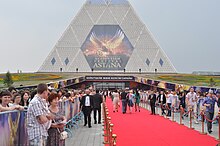
Kazakhstan's film industry is run through the state-owned Kazakhfilm studios based in Almaty. The studio has produced award-winning movies such as Myn Bala, Harmony Lessons, and Shal.[266] Kazakhstan is the host of the International Astana Action Film Festival and the Eurasia International Film Festival held annually. Hollywood director Timur Bekmambetov is from Kazakhstan and has become active in bridging Hollywood to the Kazakhstan film industry.[267]
Kazakhstan journalist Artur Platonov won Best Script for his documentary "Sold Souls" about Kazakhstan's contribution to the struggle against terrorism at the 2013 Cannes Corporate Media and TV Awards.[268][269]
Serik Aprymov's Little Brother (Bauyr) won at the Central and Eastern Europe Film Festival goEast from the German Federal Foreign Office.[270]
Media

Kazakhstan is ranked 161 out of 180 countries on the Reporters Without Borders World Press Freedom Index[271] A mid-March 2002 court order, with the government as a plaintiff, stated that Respublika were to stop printing for three months.[272] The order was evaded by printing under other titles, such as Not That Respublika.[272] In early 2014, a court also issued a cease publication order to the small-circulation Assandi-Times newspaper, saying it was a part of the Respublika group. Human Rights Watch said: "this absurd case displays the lengths to which Kazakh authorities are willing to go to bully critical media into silence."[273]
With support from the US Department of State's Bureau for Democracy, Human Rights and Labor (DRL), the American Bar Association Rule of Law Initiative opened a media support centre in Almaty to assist press outlets in Kazakhstan.[274]

UNESCO World Heritage sites
Kazakhstan has three cultural and two natural sites on the UNESCO World Heritage list. The cultural sites are:
- Mausoleum of Khoja Ahmed Yassaui, added in 2003
- Petroglyphs within the Archaeological Landscape of Tamgaly, added in 2004
- Silk Roads: the Routes Network of Chang'an-Tianshan Corridor, added in 2014
The natural sites are:
- Saryarka - Steppe and Lakes of Northern Kazakhstan, added in 2008
- Western Tien Shan, added in 2016[275]
Public holidays
See also
Explanatory notes
- ^ "Kazakhstani" refers to all citizens of Kazakhstan, regardless of ethnicity.[5]
- ^
- Kazakh: Қазақстан, romanized: Qazaqstan, pronounced [qɑzɑqsˈtɑn]
- Russian: Казахстан, romanized: Kazakhstan, pronounced [kəzɐxˈstan]
- ^
- ^ About 4% of Kazakhstan's territory, west of the Ural River, lies in Eastern Europe.[12][13]
- ^ Albania, Armenia, Azerbaijan, Belarus, Bosnia and Herzegovina, Georgia, Kazakhstan, Kosovo, Kyrgyzstan, Moldova, Montenegro, North Macedonia, Russia, Serbia, Tajikistan, Turkey, Turkmenistan, Ukraine, Uzbekistan
References
- ^ "2023 жыл басына Қазақстан Республикасы халқының саны" (PDF). stat.gov.kz. Archived from the original (PDF) on 11 June 2023.
- ^ Kazakhstan population by ethnic groups
- ^ a b c "2021 жылғы Қазақстан Республикасы халқының ұлттық санағының қорытындылары" [Results of the 2021 Population Census of the Republic of Kazakhstan] (in Kazakh). Agency of Strategic Planning and Reforms of the Republic of Kazakhstan National Bureau of Statistics. Archived from the original on 2 September 2022. Retrieved 19 September 2022.
- ^ a b c Viktorova, Polina (30 November 2022). "How the Number of Believers Changed in Kazakhstan". CABAR.asia. The Institute for War & Peace Reporting. Retrieved 11 March 2023.
- ISBN 978-3-86219-454-4. Archivedfrom the original on 27 February 2018.
- ^ "Frontline democracy and the battle for Ukraine". Democracy Index 2022. The Economist Intelligence Unit. 2023. p. 50. Retrieved 21 October 2023.
- ^ "Official website of the President of the Republic of Kazakhstan".
- ^ "Kazakhstan's population hits the mark of 20 mln". inform.kz. 16 November 2023. Retrieved 17 November 2023.
- ^ a b c d "World Economic Outlook Database, April 2024 Edition. (Kazakhstan)". www.imf.org. International Monetary Fund. 16 April 2024. Retrieved 17 April 2024.
- ^ "GINI index (World Bank estimate)". data.worldbank.org. World Bank. Archived from the original on 18 May 2020. Retrieved 25 December 2022.
- ^ "Human Development Report 2023/24" (PDF). United Nations Development Programme. 13 March 2024. Retrieved 13 March 2024.
- ISBN 978-1-84234-461-3. Retrieved 11 October 2021.
- ^ World Factbook. Washington, D.C.: Central Intelligence Agency. 29 September 2021. Archived from the original on 9 January 2021. Retrieved 23 January 2021. Kazakhstan: Geography
- ^ "Kazakhstan's population reaches 20 million. President Tokayev congratulates his fellow citizens". kursiv.kz. 16 November 2023. Archived from the original on 17 November 2023. Retrieved 17 November 2023.
- ^ Galiev, Anuar (1998). "Traditional Institutions in Modern Kazakhstan". Src-h.slav.hokudai.ac.jp. Archived from the original on 4 September 2019. Retrieved 4 December 2011.
- ^ a b c Zarakhovich, Yuri (27 September 2006). "Kazakhstan Comes on Strong". Time. Archived from the original on 7 December 2015. Retrieved 13 December 2015.
- ^ "Kazakhstan/Qazaqstan Constitution". Parliament of Kazakhstan. Archived from the original on 2 December 2016. Retrieved 27 December 2016.
- ^ a b "Democracy Index 2010: Democracy in retreat" (PDF). Economist Intelligence Unit. 6 December 2010. Archived (PDF) from the original on 13 December 2017. Retrieved 26 January 2017.
- ^ a b Democracy Index 2022
- ^ a b "Kazakhstan: Nations in Transit 2020 Country Report". Freedom House. Archived from the original on 2 June 2021. Retrieved 30 May 2021.
- ^ "Kazakh". Oxford English Dictionary (Online ed.). Oxford University Press. (Subscription or participating institution membership required.)
- ^ a b "Cossack (n.)". The Online Etymology Dictionary. Archived from the original on 2 October 2015.
- ^ Kenzheakhmet Nurlan (2013). The Qazaq Khanate as Documented in Ming Dynasty Sources. p. 133.
- ^ Barthold, V. V. (1962). Four Studies on the History of Central Asia. Vol. &thinsp, 3. Translated by V. & T. Minorsky. Leiden: Brill Publishers. p. 129.
- S2CID 145155985.
- ISBN 978-3-11-081003-5. Retrieved 14 November 2020.
- PMID 31036896.
- ^ Ismagulov, O; et al. (2010). "Physical Anthropology of Kazakh People and their Genesis". Science of Central Asia. Archived from the original on 10 February 2017. Retrieved 5 November 2022.
- ^ Gibbons, Ann (10 June 2015). "Nomadic herders left a strong genetic mark on Europeans and Asians". Science. AAAS.
- ^ According to Allentoft et al. (2015) and Haak et al. (2015),
- ISBN 978-1-4008-2994-1: "Archaeologists are now generally agreed that the Andronovo culture of the Central Steppe region in the second millennium BC is to be equated with the Indo-Iranians."
- ^ Beckwith 2009, p. 68 "Modern scholars have mostly used the name Saka to refer to Iranians of the Eastern Steppe and Tarim Basin"
- ISBN 9231028464. "In modern scholarship the name 'Sakas' is reserved for the ancient tribes of northern and eastern Central Asia and Eastern Turkestan to distinguish them from the related Massagetae of the Aral region and the Scythians of the Pontic steppes. These tribes spoke Iranian languages, and their chief occupation was nomadic pastoralism."
- PMID 31488661.
- S2CID 13670282.
The wide distribution of the Turkic languages from Northwest China, Mongolia and Siberia in the east to Turkey and Bulgaria in the west implies large-scale migrations out of the homeland in Mongolia.
The quotation is from pp. 4–5. - ^ "Kazakhstan to c. AD 1700". Encyclopædia Britannica. Archived from the original on 11 August 2015. Retrieved 1 June 2010.
- ^ "Country Briefings: Kazakhstan". The Economist. Archived from the original on 8 December 2015. Retrieved 1 June 2010.
- ^ January 2018, Assel Satubaldina in Tourism on 17 (17 January 2018). "Şymkent – the city of medieval culture and vibrant modern lifestyle". The Astana Times. Archived from the original on 7 January 2021. Retrieved 5 January 2021.
{{cite web}}: CS1 maint: numeric names: authors list (link) - ISBN 0230599427
- ISBN 0822315211
- ^ "Kazakhstan". Encyclopædia Britannica. 16 December 1991. Archived from the original on 17 June 2015. Retrieved 9 September 2013.
- ^ "Kazakhstan". Microsoft Encarta Online Encyclopedia. 2005y. Archived from the original on 15 April 2005. Retrieved 29 October 2009.
- ^ Simon Ertz (2005). "The Kazakh Catastrophe and Stalin's Order of Priorities, 1929–1933: Evidence from the Soviet Secret Archives" (PDF). Stanford's Student Journal of Russian, East European, and Eurasian Studies. 1: 1–12. Archived from the original (PDF) on 3 September 2006. Retrieved 1 June 2010.
- ^ Pianciola, Niccolò (2004). "Famine in the Steppe. The collectivization of agriculture and the Kazak herdsmen, 1928–1934". Cahiers du monde russe. 45: 137–192. Archived from the original on 23 October 2015.
- ^ Children of the gulag live with amnesiaArchived 3 March 2016 at the Wayback Machine, Taipei Times, 1 January 2007
- ISBN 1-84331-117-8
- ^ Keenan, Jillian. "Kazakhstan's Painful Nuclear Past Looms Large Over Its Energy Future". The Atlantic. Archived from the original on 2 February 2017. Retrieved 27 January 2017.
- ^ Putz, Catherine. "1986: Kazakhstan's Other Independence Anniversary". thediplomat.com. Archived from the original on 28 March 2019. Retrieved 5 January 2021.
- ^ "Nursultan: Kazakhstan renames capital Astana after ex-president". BBC News. 20 March 2019. Archived from the original on 25 December 2019. Retrieved 5 January 2021.
- ^ "Capital change: A look at some countries that have moved their capitals – Nigeria: Lagos to Abuja". The Economic Times. Archived from the original on 20 April 2021. Retrieved 5 January 2021.
- osce.org. Archivedfrom the original on 8 January 2021. Retrieved 5 January 2021.
- ^ Nazarbayev, Nursultan (28 March 2011). OP Ed: "Kazakhstan's steady progress toward democracy" Archived 10 December 2015 at the Wayback Machine, Washington Post
- ^ "Kazakh leader resigns after three decades". BBC News. 19 March 2019. Archived from the original on 25 April 2019. Retrieved 19 March 2019.
- ^ "CEC announces preliminary results of 2019 Presidential Election in Kazakhstan". inform.kz. 10 June 2019. Archived from the original on 15 August 2019. Retrieved 15 August 2019.
- ^ "Kazakhstan renames capital as new president takes office". France 24. 20 March 2019.
- ^ "Nazarbayev protégé wins Kazakhstan elections marred by protests". France 24. 10 June 2019.
- ^ "Kazakhstan protests: government resigns amid rare outbreak of unrest". the Guardian. 5 January 2022. Archived from the original on 5 January 2022. Retrieved 5 January 2022.
- ^ "Kazakhstan's Nazarbayev handed over security council job on his own will: Spokesman". www.aa.com.tr.
- ^ "Kazakhstan to change name of capital from Nur-sultan back to Astana". the Guardian. 14 September 2022.
- ISBN 978-1-317-29028-5. Retrieved 14 November 2020.
- ^ Kazakhstan – MSN Encarta. Archived from the original on 1 June 2008.
- ^ Daily Telegraph (5 April 2010). "Aral Sea 'one of the planet's worst environmental disasters'". The Daily Telegraph. London. Archived from the original on 8 April 2010. Retrieved 1 May 2010.
- .
- ^ Mineral Wealth. homestead.com
- ^ International Crisis Group. (May 2007). Central Asia's Energy Risks, Asia Report No. 133 Archived 3 March 2016 at the Wayback Machine
- ^ "Company Overview of Atyrau Refinery LLP – KazWorld.info". kazworld.info. Archived from the original on 26 October 2016.
- ^ "Table 3b. Non-OPEC Petroleum Supply". U.S. Energy Information Administration. Independent Statistics and Analysis. Tonto.eia.doe.gov. 11 May 2010. Archived from the original on 9 April 2009. Retrieved 1 June 2010.
- ^ Chilisai Phosphate Project Ore Reserve Update Archived 2 April 2016 at the Wayback Machine // SUNKAR RESOURCES PLC
- ^ THE MINERAL INDUSTRY OF KAZAKHSTAN—1997 Archived 3 March 2013 at the Wayback Machine // USGS: Phosphate Rock – Reserves
- ^ Kazakhstan accepted as 'EITI Compliant' Archived 1 January 2016 at the Wayback Machine. EITI (17 October 2013). Retrieved 8 March 2014.
- ^ "The Coldest Capital Cities In The World". WorldAtlas.com. Archived from the original on 8 January 2017. Retrieved 15 January 2017.
- ^ "Kazakhstan climate information". Weatherbase. Archived from the original on 2 January 2016. Retrieved 4 February 2016.
- ^ A.F. Kovshar (Ed.): Monitoring biologicheskogo raznoobraziya Zapovednika Aksu-Dzhabagly. In: Tethys Biodiversity Research. Tom 1, S. 17–21.
- ^ "Celestial Silk Road 5th–21st June 2016". viranatura.com. Archived from the original on 5 March 2016. Retrieved 26 May 2015.
- PMID 33293507.
- ^ "Red Book". United Nations Environment Programme (UNEP). Archived from the original on 5 February 2017. Retrieved 8 December 2016.
- ^ "Yes, Kazakhstan should change its name. This map shows why". Washington Post. Archived from the original on 11 August 2017. Retrieved 11 August 2017.
- ^ "Kazakh leader resigns after three decades". 19 March 2019. Archived from the original on 25 April 2019. Retrieved 19 March 2019.
- ^ Auyezov, Olzhas (19 March 2019). "Kazakhstan's Leader Nazarbayev Resigns After Three Decades in Power". US News. Archived from the original on 1 April 2019. Retrieved 1 April 2019.
- ^ "Nazarbayev ally wins big in Kazakhstan election after hundreds arrested". The Guardian. Archived from the original on 12 July 2019. Retrieved 12 July 2019.
- ^ "About Republic of Kazakhstan | CIS Legislation". cis-legislation.com. Archived from the original on 9 January 2021. Retrieved 5 January 2021.
- ^ "Official site of the President of the Republic of Kazakhstan – Kazakhstan". Akorda.kz. Archived from the original on 23 March 2013. Retrieved 26 March 2013.
- ^ "Kazakhstan to Liberalize Rules on Protests and Political Parties". USNews. REUTERS. Archived from the original on 24 December 2019. Retrieved 24 December 2019.
- ^ a b c d "Kazakhstan President Tokayev's initiatives on public safety, rule of law, human rights". iran-daily.com. 5 January 2020. Archived from the original on 14 January 2020. Retrieved 8 April 2020.
 Text was copied from this source, which is available under a Creative Commons Attribution 4.0 International License Archived 16 October 2017 at the Wayback Machine.
Text was copied from this source, which is available under a Creative Commons Attribution 4.0 International License Archived 16 October 2017 at the Wayback Machine.
- ^ "First glimpses of Tokayev's Kazakhstan: The listening state?". Atlantic Council. 17 September 2019. Archived from the original on 20 September 2019. Retrieved 7 April 2020.
- ^ "Kazakhstan limits presidential term, renames capital". aljazeera.com. Retrieved 21 December 2022.
- ^ a b "Tokayev bites the reform bullet". East Asia Forum. 18 November 2022. Retrieved 21 December 2022.
- ^ "Kazakhstan: Voters back reforms to reject founder's legacy". dw.com. Retrieved 21 December 2022.
- ^ a b c d "Kazakhstan, Unitary County" (PDF). www.oecd.org. Archived (PDF) from the original on 6 February 2018. Retrieved 6 February 2018.
- ^ a b "On Administrative-Territorial Division of the Republic of Kazakhstan, The Law of the Republic of Kazakhstan dated 8 December 1993". Adilet. Ministry of Justice of the Republic of Kazakhstan Republican Center of Legal Information. Archived from the original on 7 February 2018. Retrieved 7 February 2018.
- ^ a b Kazakhstan Archived 9 January 2021 at the Wayback Machine . CIA World Factbook.
- ^ Публичное подписание Указа "О некоторых вопросах административно-территориального устройства Республики Казахстан" [Public signing of the Decree "On some issues of the administrative and territorial structure of the Republic of Kazakhstan"] (in Russian). President of Kazakhstan. 19 June 2018. Archived from the original on 20 June 2018. Retrieved 21 June 2018.
- ^ "Kazakhstan renames capital to honour ex-leader". aljazeera.com. Archived from the original on 8 January 2021. Retrieved 5 January 2021.
- ^ "Обложка". stat.gov.kz. Archived from the original on 13 June 2020. Retrieved 7 December 2021.
- ^ "Kazakhstan became member of UN Human Rights Council". Tengrinews.kz English. 13 November 2012. Archived from the original on 1 January 2016.
- ^ North Atlantic Treaty Organization (5 October 2006). "Signatures of Partnership for Peace Framework Document". Archived from the original on 29 November 2006.
- ^ Iwiński, Tadeusz (7 July 2006). "Situation in Kazakhstan and its relations with the Council of Europe". Council of Europe – Parliamentary Assembly. Retrieved 14 February 2020.
For its part, the Assembly might decide, already at this stage, to interpret Rule 59 of its Rules of procedure, concerning special guests, in such a way as to include the Eurasian States. Two Council of Europe member States, Turkey and Russia, belong geographically to both Europe and Asia and are therefore Eurasian. Strictly speaking, the three South Caucasus States, Armenia, Azerbaijan and Georgia are located in Asia, yet their membership of political Europe is no longer in doubt. [...] This being the case, Kazakhstan, as a Eurasian State participating in the OSCE and a signatory to the International covenant on civil and political rights and the International covenant on economic, social and cultural rights, would meet the criteria laid down in Rule 59, making it eligible to apply for special guest status with the Assembly.
- ^ Cornell, Svante; Engvall, Johan (2017). "Kazakhstan in Europe: Why Not?" (PDF). Institute for Security & Development Policy. Archived (PDF) from the original on 24 October 2020. Retrieved 15 February 2020.
However, by 2006, a Rapporteur for the Political Affairs Committee concluded that because of Kazakhstan's nature as a European country, the country should be considered 'eligible to apply for a special guest status.'
- ^ Blank, Stephen (27 April 2005). "Kazakhstan's Foreign Policy in a Time of Turmoil". EurasiaNet. Archived from the original on 4 March 2016. Retrieved 9 April 2009.
- ^ Cohen, Ariel (7 October 2008). "Kazakh foreign minister insists balanced foreign policy remains intact". Business News Europe. Archived from the original on 17 August 2009.
- ^ Joint Statement on the meeting between President Obama and Kazakhstan president Nazarbayev | The White House Archived 16 February 2017 at the Wayback Machine. Whitehouse.gov (11 April 2010). Retrieved 14 January 2013.
- ^ "Kazakhstan, UN Continue Building on Two-Decades of Cooperation". Astanatimes.com. 27 October 2014. Archived from the original on 19 February 2016. Retrieved 14 February 2016.
- ^ "Sweden, Bolivia, Ethiopia and Kazakhstan elected to Security Council". un.org. 28 June 2016. Archived from the original on 25 November 2016. Retrieved 23 November 2016.
- ^ a b "Kazakh peacekeepers in Western Sahara". Tengrinews. Archived from the original on 8 November 2014.
- ^ "Kazakhstan delivers humanitarian aid to Ukraine". Global Post. Archived from the original on 5 February 2015.
- ^ "Nazarbayev Offers to Mediate in Ukraine, Stresses Kazakhstan's Economic Resilience". The Astana Times. Archived from the original on 8 December 2015.
- ^ a b "Nazarbayev as Mediator". Carnegie Endowment for International Peace Moscow Center. Archived from the original on 8 December 2015.
- ^ "Kazakhstan Urges Peaceful Resolution to Ukraine Conflict, Reiterates Minsk Agreements". The Astana Times. Archived from the original on 8 December 2015.
- ^ "Chapter XXVI: Disarmament – No. 9 Treaty on the Prohibition of Nuclear Weapons". United Nations Treaty Collection. 7 July 2017. Archived from the original on 6 August 2019. Retrieved 16 August 2019.
- ^ INFORM.KZ (9 March 2020). "President approves new concept of Kazakhstan's foreign policy for 2020–2030". inform.kz (in Russian). Archived from the original on 7 April 2020. Retrieved 7 April 2020.
- ^ "Twelve new members elected to World Heritage Committee". UNESCO. Archived from the original on 18 February 2016.
- ^ "Kazakhstan and the WTO". World Trade Organization. Archived from the original on 1 July 2017.
- ^ "Member States". OIC. Archived from the original on 9 June 2017.
- ^ Sanchez, Wilder Alejandro (May 2020). "A Rising Global Player: Kazakhstan's Foreign Policy in the 2020s" (PDF). Wilson Center.
- ^ Umarov, Temur (16 September 2022). "Kazakhstan Is Breaking Out of Russia's Grip". Foreign Policy. Retrieved 21 December 2022.
- ^ "Kazakhstan asserts its independent foreign policy". trendsresearch.org. Archived from the original on 21 December 2022. Retrieved 21 December 2022.
- ^ Putz, Catherine. "Yes, Kazakhstan Has a Navy". thediplomat.com. Archived from the original on 7 January 2021. Retrieved 5 January 2021.
- ^ "Kazakhstan withdraws soldiers from Iraq". Reuters. 21 October 2008. Archived from the original on 22 December 2015. Retrieved 5 January 2021.
- ^ "Steppe Eagle military exercises cover broad spectrum of scenarios". Central Asia Newswire. Archived from the original on 8 December 2015.
- ^ "Steppe Eagle – 2015 Multinational Peacekeeping Exercises to be Held in April and June". The Astana Times. Archived from the original on 8 December 2015.
- ^ "Kazakhstan to Join U.N. Peacekeeping for First Time". The New York Times.
- ^ "Global democracy has a very bad year". The Economist. 2 February 2021. Archived from the original on 26 July 2021. Retrieved 22 March 2021.
- ^ "Global democracy has another bad year". The Economist. 22 January 2020. Archived from the original on 23 March 2021. Retrieved 22 March 2021.
- ^ "Kazakhstan". Reporters Without Borders. Retrieved 8 June 2022.
- ^ Human Rights Watch, World Report 2015: Kazakhstan Archived 28 October 2016 at the Wayback Machine, accessed October 2015.
- ^ "The Kazakhstan elections and the transition that wasn't". hrw.org. 5 June 2019. Archived from the original on 1 March 2021. Retrieved 22 March 2021.
- ^ Human Rights Watch, World Report 2015: Kazakhstan Archived 28 October 2016 at the Wayback Machine, accessed September 2016.
- S2CID 159320888, retrieved 4 December 2020
- ^ Human Rights Watch, World Report 2016: Kazakhstan Archived 14 September 2016 at the Wayback Machine, accessed September 2016.
- ^ "Kazakh Opposition Activist Detained For 'Spreading False Information'". Human Rights Watch. 18 April 2020. Archived from the original on 28 July 2020. Retrieved 2 May 2020.
- from the original on 19 January 2021. Retrieved 4 December 2020.
- ^ a b "Country Reports on Human Rights Practices for 2013: Kazakhstan" Archived 18 June 2020 at the Wayback Machine, released by the Bureau of Democracy, Human Rights and Labor. Retrieved 1 November 2015.
- ^ "Rule of Law Index 2015". World Justice Project. Archived from the original on 29 April 2015. Retrieved 14 February 2016.
- ^ "Rule of Law in Kazakhstan". American Bar Association. Archived from the original on 3 March 2016.
- ^ "Kazakhstan Background". American Bar Association. Archived from the original on 3 March 2016.
- ^ "Judicial Reform". American Bar Association. Archived from the original on 3 March 2016.
- ^ "Kazakh criminal justice system to be digitised by 2018". The Astana Times. Archived from the original on 1 December 2017.
- ^ Trochev, Alexei (2017). "Between Convictions and Reconciliations: Processing Criminal Cases in Kazakhstani Courts" (PDF). Cornell Journal of International Law. 50: 107–145. Archived (PDF) from the original on 20 July 2020. Retrieved 4 December 2020.
- ISBN 978-1-78477-092-1.
- ^ "Kazakhstan: LGBT Community Living in Fear". Human Rights Watch. 23 July 2015. Archived from the original on 27 July 2019. Retrieved 16 August 2019.
- ^ "Life in the Closet: The LGBT Community in Central Asia". The Diplomat. 29 January 2019. Archived from the original on 2 August 2019. Retrieved 16 August 2019.
- ^ "stat.gov.kz". stat.gov.kz. Archived from the original on 17 October 2019. Retrieved 7 April 2020.
- ^ "GDP growth (annual %)". The World Bank. World Bank.org. Archived from the original on 31 May 2011. Retrieved 1 June 2010.
- ^ "№ 1 in the world". The Atomic Company Kazatomprom, Kazatomprom.kz. 30 December 2009. Archived from the original on 22 July 2011. Retrieved 1 June 2010.
- ^ "Uranium and Nuclear Power in Kazakhstan". world-nuclear.org. June 2022. Archived from the original on 26 March 2013. Retrieved 13 January 2023.
- ^ "Kazakhstan: The Latest Emerging Opportunity". BRIC Plus. Archived from the original on 20 June 2015.
- ^ Kazakhs battle to stave off chill blowing in from Russian steppe Archived 19 May 2020 at the Wayback Machine, Financial Times, 21 May 2014
- ^ "Tenge Fever", The Economist, 22 February 2014
- ^ Kazakhstan's currency plunges Archived 5 February 2017 at the Wayback Machine, The New York Times, 21 August 2015
- ^ "Kazakhstan profile". State.gov. US State Department. Archived from the original on 4 August 2019. Retrieved 14 February 2016.
- ^ "Kazakhstan unveils $21bn rescue package". Financial Times. Archived from the original on 16 October 2015.
- ^ "IMF Executive Board Article IV consultation1 with Kazakhstan". Imf.org. International Monetary Fund. Archived from the original on 3 March 2016. Retrieved 14 February 2016.
- ^ "Kazakhstan Profile". The World Bank. Archived from the original on 11 September 2014.
- ISBN 9781514528488.
- ^ "Fitch Affirms Kazakhstan at "BBB"; Outlook Stable". fitchratings.com. Archived from the original on 8 January 2021. Retrieved 5 January 2021.
- ^ "Unified Pension Fund Recommended in Kazakhstan". The Gazette of Central Asia. Satrapia. 23 January 2013. Archived from the original on 8 December 2015.
- ^ "Economic Freedom Index". The Heritage Foundation. Archived from the original on 26 October 2017.
- ^ "China's new Silk Road traverses Kazakhstan. But some Kazakhs are skeptical of Chinese influence". pri.org. Archived from the original on 8 May 2021. Retrieved 27 May 2021.
- ^ "WTO: Kazakhstan". WTO.org. Archived from the original on 1 July 2017. Retrieved 28 May 2021.
- ^ "Kazakhstan's foreign trade turnover rises by 19.7% in 2018". Kazinform. 13 February 2019. Archived from the original on 29 October 2019. Retrieved 29 October 2019.
- ^ "Kazakhstan increased exports nearly 25 percent in 2018". astanatimes.com. 18 April 2019. Archived from the original on 6 August 2019. Retrieved 27 November 2019.
- ^ "Arable Land per inhabitant World Bank database". The World Bank. Archived from the original on 10 February 2015.
- ^ Shepard, Wade. "How Kazakhstan Is Becoming The Next Frontier For World-Class Wine". Forbes. Archived from the original on 7 January 2021. Retrieved 5 January 2021.
- ^ "Kazakhstan energy profile – Analysis". IEA. 15 April 2020. Archived from the original on 8 January 2021. Retrieved 5 January 2021.
- ^ Chevron-led Kazakh oil firm hits record output in 2013, International: Reuters, 2014, archived from the original on 7 January 2022, retrieved 7 January 2022
- PennWell Corporation. 28 June 2012. Archivedfrom the original on 7 January 2022. Retrieved 7 January 2022.
- ^ "Tracing the Chinese Footprints in Kazakhstan's Oil and Gas Industry". The Diplomat. 12 December 2020. Archived from the original on 7 January 2022. Retrieved 7 January 2022.
- ^ "Kazakhstan: Green economy reforms gain momentum". UNDP. Archived from the original on 27 November 2019. Retrieved 27 November 2019.
- ^ Uyzbayeva, Aigerim (February 2015). "Towards Achieving Energy Efficicency in Kazakhstan". International Conference on Energy Efficiency and Renewable Energy Technology (ICEERET2015). 9. Archived from the original on 12 October 2017 – via ResearchGate.
- ^ "Kazakhstan Sets Prices for Energy From Renewable Sources". Bloomberg News. Archived from the original on 9 March 2017.
- ^ a b "The World Factbook — Central Intelligence Agency". cia.gov. Archived from the original on 9 January 2021. Retrieved 25 September 2017.
- ^ "Loco manufacturer obtains first IRIS certification in Kazakhstan". railwaygazette.com. Archived from the original on 13 May 2018. Retrieved 12 May 2018.
- ^ "Alstom inaugurated first locomotive repairing centre in Kazakhstan". raillynews.com. Archived from the original on 13 May 2018. Retrieved 12 May 2018.
- ^ "Astana Nurly Zhol station inaugurated". railjournal.com. 2 June 2017. Archived from the original on 13 May 2018. Retrieved 12 May 2018.
- ^ "urbanrail.net". Archived from the original on 25 April 2015. Retrieved 25 September 2017.
- ^ "No Light Rail Transport for Astana". Tengrinews.kz. 28 November 2013. Archived from the original on 26 September 2017. Retrieved 25 September 2017.
- ^ UK, DVV Media. "Astana light rail framework agreement signed". Archived from the original on 2 July 2017. Retrieved 25 September 2017.
- ^ Pavlodar
- ^ "Khorgos: The New Silk Road's Central Station Comes To Life". forbes.com. Archived from the original on 13 May 2018. Retrieved 12 May 2018.
- ^ Anonymous (22 September 2016). "Aviation Safety: Commission updates EU air safety list – Iran and Africa make progress". Mobility and Transport – European Commission. Archived from the original on 7 January 2021. Retrieved 5 January 2021.
- ^ "Sustained safety effort pulled Kazakhstan off EU blacklist". flightglobal.com. Archived from the original on 7 November 2017.
- ^ Joanna Lillis for EurasiaNet, part of the New East (17 July 2014). "Summer holiday in Kazakhstan? Astana eases visa restrictions to attract tourists | World news". The Guardian. Archived from the original on 3 May 2019. Retrieved 18 November 2015.
- ^ "Kazakhstan: Astana Announces Visa-Free Travel for 10 High-Investing States". EurasiaNet.org. 16 June 2014. Archived from the original on 17 November 2015. Retrieved 18 November 2015.
- ^ "Rankings". Archived from the original on 25 September 2019. Retrieved 19 November 2020.
- ^ a b c d Lillis, Joanna (17 July 2014). "Summer holiday in Kazakhstan? Astana eases visa restrictions to attract tourists". The Guardian. Archived from the original on 3 May 2019. Retrieved 11 December 2015.
- ^ "Kazakhstan to develop its tourism industry. Environment. Tengrinews.kz". En.tengrinews.kz. 18 June 2014. Archived from the original on 19 November 2015. Retrieved 18 November 2015.
- ^ "Visa and passport". Timatic. International Air Transport Association through Emirates. Retrieved 1 April 2017.
- ^ "Visa Regime of Kazakhstan with other countries" (in Russian). The Ministry of foreign Affairs of the Republic of Kazakhstan. 3 June 2017. Archived from the original on 9 June 2017. Retrieved 22 June 2017.
- ^ September 2019, Dilshat Zhussupova in Nation on 11 (11 September 2019). "Kazakhstan attracts $330 billion FDI since 1991". The Astana Times. Archived from the original on 11 September 2019. Retrieved 7 April 2020.
{{cite web}}: CS1 maint: numeric names: authors list (link) - ^ "2015 Investment Climate Statement – Kazakhstan" (PDF). US State Department. Archived (PDF) from the original on 30 July 2019. Retrieved 21 May 2019.
- ^ a b "Kazakhstan Enacts Investor Tax Breaks". Tax News. Archived from the original on 1 July 2014. Retrieved 18 June 2014.
- ^ Kazakhstan attractiveness survey 2013. EY.com Archived 8 March 2014 at the Wayback Machine
- ^ "Kazakhstan targets to invite USD 34 bln of investments by 2025". Kazinform. 26 September 2019. Archived from the original on 24 October 2019. Retrieved 24 October 2019.
- ^ "EBRD and Kazakhstan agree historic partnership to boost reform and investment". EBRD. Archived from the original on 25 May 2014.
- ^ "Nazarbayev Announces Plans for New Major Incentives for Foreign Investors". Astanatimes.com. 5 May 2014. Archived from the original on 19 February 2016. Retrieved 14 February 2016.
- ^ "OECD Investment Policy Reviews: Kazakhstan 2017". OECD.org. OECD. Archived from the original on 17 November 2017.
- ^ Vakulchuk, Roman and Indra Overland (2019) "China's Belt and Road Initiative through the Lens of Central Asia Archived 24 October 2021 at the Wayback Machine", in Fanny M. Cheung and Ying-yi Hong (eds) Regional Connection under the Belt and Road Initiative. The Prospects for Economic and Financial Cooperation. London: Routledge, pp. 115–133.
- ^ "The Global Competitiveness Report 2010–2011" (PDF). Archived (PDF) from the original on 6 December 2010. Retrieved 24 July 2011.
- ^ "Kazakh TV – Kazakhstan enters top 50 most competitive countries". Kazakh-tv.kz. 6 September 2013. Archived from the original on 20 February 2014. Retrieved 9 September 2013.
- ^ "Doing Business 2020" (PDF). Doing Business. Archived (PDF) from the original on 5 January 2020. Retrieved 7 April 2020.
- ^ a b c "Staying Competitive in a Toughening External Environment". Astanatimes.com. 16 September 2014. Archived from the original on 19 February 2016. Retrieved 14 February 2016.
- ^ Oil, Cash and Corruption Archived 5 February 2017 at the Wayback Machine, The New York Times, 5 November 2006
- ^ a b OECD Investment Policy Reviews, P112, OECD, 2012
- ^ "Kazakhstan should build on its efforts to fight corruption and push forward with reforms". OECD. Archived from the original on 26 October 2017.
- ^ "Kazakhstan removed from list of most corrupt countries". The Astana Times. March 2018. Archived from the original on 25 December 2019. Retrieved 25 December 2019.
- ^ a b Gretta Fenner Zinkernagel; Kodjo Attisso. "Returning Stolen Assets – Learning from past practice: Selected case studies" (PDF). International Centre for Asset Recovery. p. 5. Archived from the original (PDF) on 18 August 2016. Retrieved 19 July 2016 – via Basel Institute on Governance.
- ^ "Signing of a Mutual Legal Assistance Treaty Between the United States and Kazakhstan". U.S. Department of State. US State Department. Archived from the original on 30 January 2017. Retrieved 24 June 2017.
- ^ "The ABCs of the CPI: How the Corruption Perceptions Index is calculated". Transparency.org. 20 December 2021. Retrieved 30 March 2023.
- ^ "Corruption Perceptions Index 2023: Kazakhstan". Transparency.org. Retrieved 30 March 2024.
- ^ "CPI 2023 for Eastern Europe & Central Asia: Autocracy & weak justice systems enabling widespread corruption". Transparency.org. Retrieved 30 March 2024.
- ^ a b Innovation Performance Review. New York and Geneva: United Nations Economic Commission for Europe. 2012.
- ^ ISBN 978-92-3-100129-1.
- . Retrieved 29 October 2023.
- ^ "Kazakhstan's Digitization Program Brings Additional $2 billion Into the Economy". The Astana Times. 18 June 2020. Archived from the original on 22 June 2020. Retrieved 20 June 2020.
- ^ "Population Clock: World". census.gov. Archived from the original on 30 May 2019. Retrieved 30 May 2019.
- ^ "World Population Prospects 2022". United Nations Department of Economic and Social Affairs, Population Division. Retrieved 17 July 2022.
- ^ "World Population Prospects 2022: Demographic indicators by region, subregion and country, annually for 1950-2100" (XSLX) ("Total Population, as of 1 July (thousands)"). United Nations Department of Economic and Social Affairs, Population Division. Retrieved 17 July 2022.
- ^ "Негізгі". stat.gov.kz. Archived from the original on 30 May 2019. Retrieved 30 May 2019.
- ^ Kazakhstan's population increases by 1.7 per cent over a year Archived 8 December 2015 at the Wayback Machine. bnews.kz. 15 August 2013
- S2CID 219657282.
- ^ Remembering Stalin's deportations Archived 6 June 2013 at the Wayback Machine, BBC News, 23 February 2004
- ^ Clarey, Christopher (1 January 2007). "Politics, economics and time bury memories of the Kazakh gulag". International Herald Tribune. Archived from the original on 4 January 2007. Retrieved 9 September 2013.
- ^ Greenall, Robert (23 November 2005). "Russians left behind in Central Asia". BBC News. Archived from the original on 11 September 2013. Retrieved 9 September 2013.
- ^ Kazakhstan: Special report on ethnic Germans Archived 8 December 2015 at the Wayback Machine, IRIN Asia, 1 February 2005
- ^ "Central Asia's Koreans in Korea: There and (Mostly) Back Again". openDemocracy. Archived from the original on 9 January 2021. Retrieved 5 January 2021.
- ^ "From Samarkand to Seoul: Central Asian migrants in South Korea | Eurasianet". eurasianet.org. Archived from the original on 9 January 2021. Retrieved 5 January 2021.
- ^ "Kazakhstan – People". Encyclopædia Britannica. Archived from the original on 17 June 2015. Retrieved 5 January 2021.
- ^ "Constitution of the Republic of Kazakhstan"[permanent dead link]. Official website of the President of the Republic of Kazakhstan.
- ISBN 978-1-78477-092-1.
- ^ "The Languages spoken in Kazakhstan". Studycountry. Archived from the original on 11 August 2017. Retrieved 11 August 2017.
- ^ "Lost in translation? Kazakh leader bans cabinet from speaking Russian Archived 25 May 2018 at the Wayback Machine". Reuters. 27 February 2018.
- ^ Kazakh language to be converted to Latin alphabet – MCS RK Archived 19 February 2017 at the Wayback Machine. Inform.kz (30 January 2015). Retrieved 28 September 2015.
- ^ "Kazakhstan in 2013". Ministry of National Economy of the Republic of Kazakhstan Committee on Statistics. 2014. p. 33. Archived from the original on 29 September 2015.
- ^ "Address of the Head of State Nursultan Nazarbayev to the people of Kazakhstan". Mission of Kazakhstan to the United Nations. 19 March 2019. Archived from the original on 22 March 2019. Retrieved 22 March 2019.
- ^ AsiaNews.it. "Restrictive new law on religious freedom is unconstitutional". www.asianews.it. Archived from the original on 8 January 2021. Retrieved 5 January 2021.
- ^ a b c d Religious Situation Review in Kazakhstan Archived 11 May 2010 at the Wayback Machine Congress of World Religions. Retrieved 7 September 2009.
- ^ "Pew Forum on Religious & Public life, Chapter 1: Religious Affiliation". 9 August 2012. Archived from the original on 26 December 2016. Retrieved 27 December 2016.
- ISBN 978-1-78477-092-1.
- ^ a b c Kazakhstan – International Religious Freedom Report 2008 Archived 2 October 2017 at the Wayback Machine U.S. Department of State. Retrieved 7 September 2009.
- ^ "KAZAKHSTAN: Ahmadi Muslim mosque closed, Protestants fined 100 times minimum monthly wage". Forum 18. Archived from the original on 6 June 2014. Retrieved 6 June 2014.
- ^ Islam in Kazakhstan Archived 18 September 2009 at the Wayback Machine. Retrieved 7 September 2009.
- ^ "KAZAKHSTAN: "Mosques cannot be independent"". Forum 18. Archived from the original on 6 June 2014. Retrieved 6 June 2014.
- ^ "Kazakhstan". United States Commission on International Religious Freedom. United States Department of State. 26 October 2009. Archived from the original on 22 May 2019. Retrieved 3 June 2010.
- ^ "Нац состав.rar". Archived from the original on 23 July 2011. Retrieved 24 July 2011.
- ^ a b "Kazakhstan Colleges and Universities". CollegeAtlas. Archived from the original on 6 June 2014. Retrieved 3 June 2014.
- ISBN 978-1-78477-092-1.
- ^ UNESCO-UNEVOC (August 2012). "Vocational Education in Kazakhstan". Archived from the original on 7 June 2014. Retrieved 3 June 2014.
- ^ More than 2.5 thousand students get loans in Kazakhstan – News Feed – Bnews.kz: breaking news Archived 8 December 2015 at the Wayback Machine. Bnews.kz. Retrieved 20 August 2013.
- ^ a b "World Bank Supports Better Skills for Quality Jobs in Kazakhstan". Finchannel.com. Archived from the original on 9 March 2016. Retrieved 14 February 2016.
- ^ Atabaki, Touraj. Central Asia and the Caucasus: transnationalism and diaspora, pg. 24
- ^ Ibn Athir, volume 8, pg. 396
- ^ a b c d e f Walter Feldman. "Kazakh literature". Encyclopædia Britannica. Archived from the original on 2 April 2019. Retrieved 31 October 2017.
- ^ a b Aitjan Nurmanova (September 2000). "La tradition historique orale des Kazakhs". Cahiers d'Asie Centrale. 2000 (8). Translated by Alié Akimova: 93–100. Archived from the original on 8 November 2016. Retrieved 10 May 2018.
- S2CID 162799102.
- ^ GÖMEC, Saadettin (2009). "The Identity of Oguz Kagan, the Oguz in the History and the Epics of Oguz Kagan". Turkish Studies. 4 (8): 133–145.
- ISBN 9780313056185– via Google Books.
- ^ "From Folklore to Soviet National Culture: The Process of Formation of "Kazak National Music" (1920–1942)". src-h.slav.hokudai.ac.jp. Archived from the original on 18 September 2021. Retrieved 18 September 2021.
- ^ "From Folklore to Soviet National Culture- The Process of Formation of "Kazak National Music"(1920–1942)-". src-h.slav.hokudai.ac.jp. Archived from the original on 18 September 2021. Retrieved 18 September 2021.
- ^ "A. KASTEYEV STATE MUSEUM OF ARTS OF THE REPUBLIC OF KAZAKHSTAN". Archived from the original on 10 January 2021. Retrieved 5 January 2021.
- ^ "10 Most Popular Kazakhstani Dishes". tasteatlas.com. Archived from the original on 17 April 2021. Retrieved 25 March 2021.
- ^ "Cuisine of Kazakhstan". Oriental Express Central Asia. Archived from the original on 18 January 2017. Retrieved 17 January 2017.
- ^ "2011 Asian Winter Games". International Ice Hockey Federation. Archived from the original on 7 November 2017. Retrieved 5 November 2017.
- ^ "Ставки на Футбол – bandy2012.kz". 13 March 2021. Archived from the original on 24 January 2012.
- ^ "Team picture after the bronze medal had been captured in WCS 2015". Archived from the original on 9 April 2015. Retrieved 10 May 2018.
- ^ "News – XXXV Чемпионат мира по хоккею с мячом". bandyvm2015.ru. Archived from the original on 4 June 2016. Retrieved 10 May 2018.
- ^ "Kazakhfilm Studios". IMDbPro.com. Retrieved 10 October 2022.
- ISBN 978-1-78701-960-7.
- ^ CCS · Artur Platonov wins Cannes Corporate Media & TV Award 2013 Archived 1 January 2016 at the Wayback Machine. Ortcom.kz (5 November 2013). Retrieved 8 March 2014.
- ^ Cannes Corporate Media & TV Awards: Winners 2013 Archived 7 September 2015 at the Wayback Machine. Cannescorporate.com. Retrieved 8 March 2014.
- ^ "Kazakhstan's Little Brother takes Federal Foreign Office award at goEast". TengriNews. 20 April 2014. Archived from the original on 12 July 2014.
- ^ "World Press Freedom Index 2014". Reporters Without Borders. Archived from the original on 14 February 2014. Retrieved 31 August 2014.
- ^ a b Wines, Michael (13 July 2002). "Wines 2012". The New York Times. Archived from the original on 28 September 2013.
- ^ "Kazakhstan: Newspaper Closing a Blow to Free Speech". Human Rights Watch. 22 April 2014. Archived from the original on 30 August 2014. Retrieved 31 August 2014.
- ^ "Access to Justice and Human Rights". American Bar Association. Archived from the original on 4 March 2016. Retrieved 27 November 2013.
- ^ "Kazakhstan". UNESCO. Archived from the original on 30 May 2016.
![]() This article incorporates text from a free content work. Licensed under CC BY-SA IGO 3.0. Text taken from UNESCO Science Report: towards 2030, 365–387, UNESCO, UNESCO Publishing.
This article incorporates text from a free content work. Licensed under CC BY-SA IGO 3.0. Text taken from UNESCO Science Report: towards 2030, 365–387, UNESCO, UNESCO Publishing.
Further reading
- Alexandrov, Mikhail (1999). Uneasy Alliance: Relations Between Russia and Kazakhstan in the Post-Soviet Era, 1992–1997. Westport, CT: Greenwood Press. ISBN 0-313-30965-5.
- Cameron, Sarah. (2018) The Hungry Steppe: Famine, Violence, and the Making of Soviet Kazakhstan (Cornell University Press, 2018) online review Archived 10 April 2021 at the Wayback Machine
- Clammer, Paul; Kohn, Michael & Mayhew, Bradley (2004). Lonely Planet Guide: Central Asia. Oakland, CA: Lonely Planet. ISBN 1-86450-296-7.
- Cummings, Sally (2002). Kazakhstan: Power and the Elite. London: Tauris. ISBN 1-86064-854-1.
- Demko, George (1997). The Russian Colonization of Kazakhstan. New York: Routledge. ISBN 0-7007-0380-2.
- Fergus, Michael & Jandosova, Janar (2003). Kazakhstan: Coming of Age. London: Stacey International. ISBN 1-900988-61-5.
- George, Alexandra (2001). Journey into Kazakhstan: The True Face of the Nazarbayev Regime. Lanham: University Press of America. ISBN 0-7618-1964-9.
- Martin, Virginia (2000). Law and Custom in the Steppe. Richmond: Curzon. ISBN 0-7007-1405-7.
- Nahaylo, Bohdan and Victor Swoboda. Soviet Disunion: A History of the Nationalities problem in the USSR (1990) excerpt Archived 16 March 2021 at the Wayback Machine
- Nazarbayev, Nursultan (2001). Epicenter of Peace. Hollis, NH: Puritan Press. ISBN 1-884186-13-0.
- Nazpary, Joma (2002). Post-Soviet Chaos: Violence and Dispossession in Kazakhstan. London: Pluto Press. ISBN 0-7453-1503-8.
- Olcott, Martha Brill (2002). Kazakhstan: Unfulfilled Promise. Washington, DC: ISBN 0-87003-189-9.
- Rall, Ted (2006). Silk Road to Ruin: Is Central Asia the New Middle East?. New York: NBM. ISBN 1-56163-454-9.
- Rashid, Ahmed. The Resurgence of Central Asia: Islam or Nationalism? (2017)
- Robbins, Christopher (2007). In Search of Kazakhstan: The Land That Disappeared. London: Profile Books. ISBN 978-1-86197-868-4.
- Rosten, Keith (2005). Once in Kazakhstan: The Snow Leopard Emerges. New York: iUniverse. ISBN 0-595-32782-6.
- Smith, Graham, ed. The Nationalities Question in the Soviet Union (2nd ed. 1995)
- Thubron, Colin (1994). The Lost Heart of Asia. New York: HarperCollins. ISBN 0-06-018226-1.
External links
General
- Caspian Pipeline Controversy from the Dean Peter Krogh Foreign Affairs Digital Archives
- Country Profile from BBC News.
- Kazakhstan. The World Factbook. Central Intelligence Agency.
- Kazakhstan information from the United States Department of State
- Portals to the World from the United States Library of Congress.
- Kazakhstan at UCB Libraries GovPubs.
- Ministry of Foreign Affairs of the Republic of Kazakhstan Archived 29 September 2011 at the Wayback Machine
- World Bank Data & Statistics for Kazakhstan
- Kazakhstan Internet Encyclopedia
- Kazakhstan at 20 years of independence, The Economist, 17 December 2011
- "Blowing the lid off" – Unrest in Kazakhstan, The Economist, 20 December 2011
- The Region Initiative (TRI)
- Kazakhstan at Curlie
 Wikimedia Atlas of Kazakhstan
Wikimedia Atlas of Kazakhstan Geographic data related to Kazakhstan at OpenStreetMap
Geographic data related to Kazakhstan at OpenStreetMap- Country Facts from Kazakhstan Discovery
- 2008 Human Rights Report: Kazakhstan. Department of State; Bureau of Democracy, Human Rights and Labor
- Key Development Forecasts for Kazakhstan from International Futures.
Government
- Ministry of Foreign Affairs of the Republic of Kazakhstan Archived 29 September 2011 at the Wayback Machine
- E-Government of the Republic of Kazakhstan
- Government of Kazakhstan
- Chief of State and Cabinet Members
Trade


